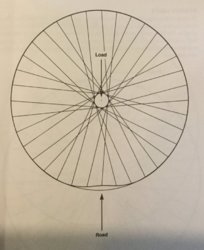What strikes me about all these "hang or stand" threads is that generally everyone seems to agree about the detail of what's actually happening (see Yellowsaddle's or Ajax Bay's drawings back on page 3, or roubaixtuesday's post above), and that the argument is about how to describe what's happening in words.
Not really, there wasn't any consent here, if any, until just a few months ago. It wasn't just the nomenclature, it was the concept.
This week saw a milestone on this forum. It's been four years on this forum of arguing the case before one person saw the light, maybe a year ago, I'm not exactly sure. In the last week, a flood of others finally grasped as well. In those four years the naysayers were loud, overwhelming and acting like a mob. In those four years I've repeatedly suggested a simple experiment to empirically prove the point and help with the understanding, but not a single person took me up on it, relying instead on intuition and common sense, both of where were out of kilter. The experiment is extremely simple and requires no equipment other than a bike and a buddy. In those four years we've had several engineers promising me that they would produce a force diagram showing their version of a model, but none came to the party, usually buggering off on a huff because of the way I sometimes say things, using that as an excuse to not face their limitations.
I can't list the number of fallacies committed in the process on my hands and toes. I don't have enough digits. The fallacies range from ad-hominem (the most common), to appeal to authority, straw man arguments, argument from popularity, faulty comparison, you name it, it was committed. It got real nasty at times. At least one reasonable man left the forum because of that.
What absolutely surprised me is that the suggestion of pressing the wheel against a wall (one I tried several times before) and the new one of pressing the wheel against the ceiling, helped one or two people grasped the concept. That I'm very happy about and I'll use that in future and certainly when I get an opportunity again one day to teach it to structural engineering students.
I still maintain that the correct terminology is to say the load stands on the bottom spokes. The fact that the mechanism is reversed doesn't matter, it is just a brain-switch you need to make. Looking at the tension graphs show it empirically.
This tread should become a sticky.


 I'll let other say you are correct. Seriously you are right. I could put a lot more properties etc in but the principle remains the same.
I'll let other say you are correct. Seriously you are right. I could put a lot more properties etc in but the principle remains the same. Thank you, I will enjoy reading that.
Thank you, I will enjoy reading that.